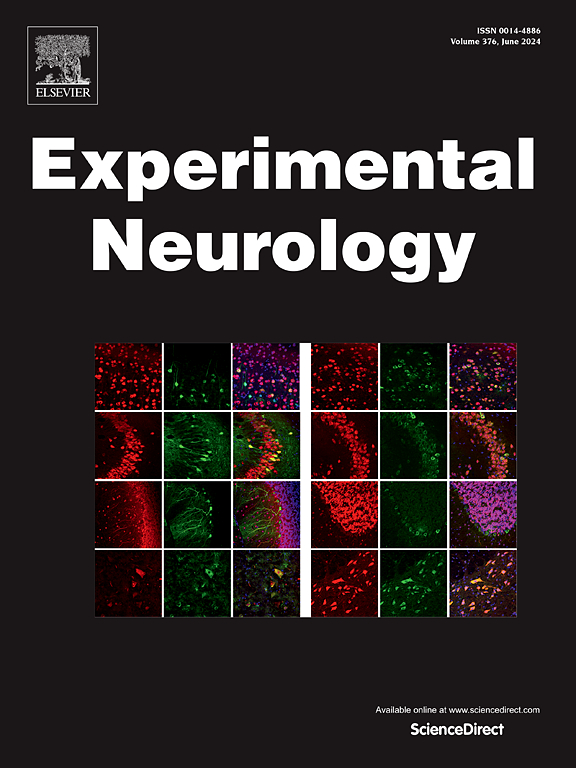Treadmill exercise supplemented by OPN promote axon regeneration through the IGF-1R/Akt/mTOR signaling pathway
IF 4.6
2区 医学
Q1 NEUROSCIENCES
引用次数: 0
Abstract
Regeneration of the corticospinal tract (CST) is considered a therapeutic target to achieve improved recovery of motor function after spinal cord injury (SCI), which is an incurable CNS damage that affects millions of people. Exercise training is effective in improving multiple functions in spinal cord-injured patients. However, the effects of exercise training on axon regeneration have not been sufficiently reported. Osteopontin (OPN) has great potential application as a neuroprotective agent for the repair of the nervous system. Studies have shown that the extent of axon regeneration strongly correlates with the expression of OPN. Our previous studies demonstrated that treadmill exercise supplemented by OPN enhances motor function recovery, but axon regeneration is still limited. Extending the treadmill exercise for 12 weeks, we observed promoted axon regeneration, motor function improvement, and signaling pathway activation in mice with SCI after supplementing OPN. Axon regeneration was observed with an anterograde tracer, motor function recovery was evaluated by animal ethology and electrophysiology, and the levels of IGF-1R/Akt/mTOR signaling pathway were evaluated. The results showed that the CST of C5 crushed mice regenerated and formed synaptic connections with neurons after treadmill exercise supplemented by OPN, the horizontal ladder and cylinder rearing test of injured limbs were improved, motor evoked potential also suggested enhanced nerve conduction, and the expression of p-IR, p-Akt, and p-S6 were increased. And the improvements were more obvious than that of the exercise group. Collectively, our study found that treadmill exercise supplemented by OPN promote axon regeneration and motor function through the IGF-1R/Akt/mTOR signaling pathways, and these improvements can be inhibited by rapamycin and Methyl-β-CD(M-B-CD).

跑步机运动补充OPN通过IGF-1R/Akt/mTOR信号通路促进轴突再生。
脊髓损伤(SCI)是一种无法治愈的中枢神经系统损伤,影响了数百万人,皮质脊髓束(CST)的再生被认为是实现脊髓损伤后运动功能改善恢复的治疗目标。运动训练能有效改善脊髓损伤患者的多种功能。然而,运动训练对轴突再生的影响尚未得到充分的报道。骨桥蛋白作为一种神经保护剂,在神经系统修复方面具有广阔的应用前景。研究表明,轴突再生的程度与OPN的表达密切相关。我们之前的研究表明,跑步机运动补充OPN可以增强运动功能恢复,但轴突再生仍然有限。延长跑步机运动12 周,我们观察到补充OPN后促进脊髓损伤小鼠轴突再生、运动功能改善和信号通路激活。用顺行示踪剂观察轴突再生,用动物行为学和电生理学评估运动功能恢复,并评估IGF-1R/Akt/mTOR信号通路的水平。结果显示,在跑步机运动补充OPN后,C5损伤小鼠CST再生并与神经元形成突触连接,损伤肢体水平阶梯和圆柱饲养实验改善,运动诱发电位提示神经传导增强,p-IR、p-Akt、p-S6表达增加。这种改善比运动组更明显。总的来说,我们的研究发现,跑步机运动补充OPN通过IGF-1R/Akt/mTOR信号通路促进轴突再生和运动功能,而这些改善可以被雷帕霉素和甲基β- cd (M-B-CD)抑制。
本文章由计算机程序翻译,如有差异,请以英文原文为准。
求助全文
约1分钟内获得全文
求助全文
来源期刊

Experimental Neurology
医学-神经科学
CiteScore
10.10
自引率
3.80%
发文量
258
审稿时长
42 days
期刊介绍:
Experimental Neurology, a Journal of Neuroscience Research, publishes original research in neuroscience with a particular emphasis on novel findings in neural development, regeneration, plasticity and transplantation. The journal has focused on research concerning basic mechanisms underlying neurological disorders.
 求助内容:
求助内容: 应助结果提醒方式:
应助结果提醒方式:


